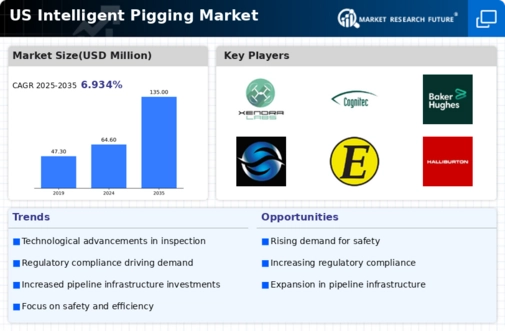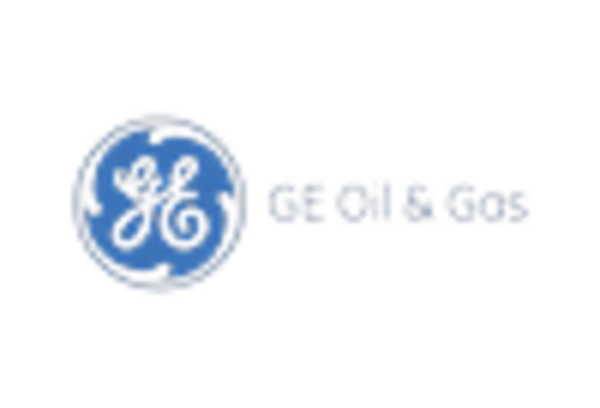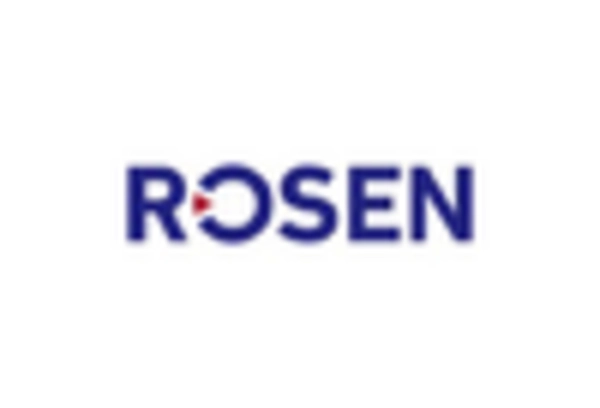Rising Environmental Regulations
The intelligent pigging market is increasingly shaped by rising environmental regulations aimed at minimizing the ecological impact of pipeline operations. Regulatory agencies are enforcing stricter guidelines regarding emissions and spill prevention, compelling operators to adopt more effective monitoring solutions. Intelligent pigging technologies enable companies to comply with these regulations by providing detailed insights into pipeline conditions and potential risks. As a result, the market is projected to expand as organizations invest in intelligent pigging to meet compliance requirements. The anticipated growth in the intelligent pigging market is expected to be around 6% annually, driven by the need for enhanced environmental stewardship and regulatory adherence.
Growing Demand for Pipeline Safety
The intelligent pigging market is significantly influenced by the growing demand for pipeline safety. With increasing concerns over environmental impacts and the potential for catastrophic failures, operators are prioritizing the integrity of their pipelines. Intelligent pigging provides a proactive approach to monitoring and maintaining pipeline health, thereby reducing the risk of leaks and spills. In the US, regulatory bodies are tightening safety standards, which further propels the adoption of intelligent pigging technologies. The market is expected to reach a valuation of approximately $1.2 billion by 2027, reflecting the heightened focus on safety and compliance. This trend indicates that stakeholders are increasingly recognizing the value of investing in intelligent pigging solutions to ensure operational safety and environmental protection.
Increased Investment in Infrastructure
The intelligent pigging market is benefiting from increased investment in infrastructure across various sectors, particularly in oil and gas. As the US government and private entities allocate substantial funds for upgrading aging pipeline systems, the demand for intelligent pigging technologies is likely to rise. This investment is crucial for enhancing the efficiency and safety of pipeline operations. According to recent estimates, the US is expected to invest over $200 billion in infrastructure improvements by 2028, which includes significant allocations for pipeline maintenance and monitoring. Consequently, the intelligent pigging market is poised for growth as operators seek advanced solutions to ensure the reliability and safety of their infrastructure.
Advancements in Pipeline Inspection Technology
The intelligent pigging market is experiencing a surge due to advancements in pipeline inspection technology. Innovations such as high-resolution imaging and real-time data analytics are enhancing the capabilities of intelligent pigs. These technologies allow for more accurate detection of anomalies, corrosion, and other pipeline integrity issues. As a result, operators can make informed decisions regarding maintenance and repairs, potentially reducing downtime and operational costs. The market for intelligent pigging solutions is projected to grow at a CAGR of approximately 7.5% from 2025 to 2030, driven by these technological advancements. Furthermore, the integration of artificial intelligence and machine learning into inspection processes is expected to further optimize performance, making the intelligent pigging market increasingly attractive to stakeholders in the energy sector.
Shift Towards Predictive Maintenance Strategies
The intelligent pigging market is witnessing a shift towards predictive maintenance strategies, which are becoming increasingly popular among pipeline operators. This approach leverages data collected from intelligent pigs to forecast potential failures and maintenance needs, thereby optimizing operational efficiency. By transitioning from reactive to predictive maintenance, companies can significantly reduce costs associated with unplanned outages and repairs. The intelligent pigging market is projected to grow as organizations recognize the financial benefits of predictive maintenance. It is estimated that companies implementing these strategies can save up to 30% on maintenance costs, further driving the adoption of intelligent pigging technologies in the industry.

















Leave a Comment